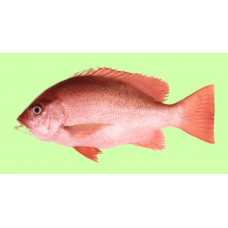Latin name
Lutjanus erythropterus
Other name
Crimson seaperch, high-brow sea-perch, Longman's sea perch, red bream, saddle-tailed perch, small-mouth nannygai or smallmouth sea perch.
Identification
The body of the Crimson Snapper is spindle-shaped, moderately large and 2.5-3.0 times the standard body length. The snout is long and slightly pointed. The mouth is relatively small. The upper profile of the head is slightly oblique. The preorbital bone is narrow, its width less than the diameter of the eye. The preorbital groove and convexity are poorly developed. The length of the upper jaw is less than the distance between the base of the last rays of the dorsal fin and the rays of the anal fin. There are teeth on the scutellum and palate; the tongue is toothless; on the scutellum the teeth are arranged in a triangular or crescent shape without a central projection. The first gill arch has 18-19 gill stamens, of which 13-14 on the lower part (including rudimentary). Above the lateral line, rows of scales run obliquely to the lateral line.
Features of fish fins
The dorsal fin has 10 hard and 12-14 soft rays. The anal fin has 3 hard and 8-9 soft rays. The posterior edge of the dorsal and anal fins is rounded. The pectoral fins have 16-17 soft rays, the ends of the fins reaching the anus. The caudal fin is slightly concave.
Fish colouring
The overall colouration of the head, body and fins of the Crimson Snapper is pink to red. In juveniles, a broad oblique black stripe runs from the mouth to the beginning of the base of the dorsal fin. At the base of the caudal fin there is a large black spot, partly with narrow red stripes.
Distribution
Widespread in the Indo-Pacific from Australia and New Guinea to the Gulf of Oman. In the western Pacific they are found as far north as Japan.
Habitat
Tropical marine benthopelagic fishes. They live near rocky and coral reefs over sandy and stony substrates at depths of 5 to 100 metres.
Size
Crimson snapper maximum length 81.6 cm, usually up to 45 cm. Maximum lifespan is 8 years.
Behavior
Juveniles are found in shallow estuaries over sandy, muddy and sandy/rubble substrates. Adults inhabit trawl grounds and reefs. Usually in schools.
Food and feeding habits
They feed on fish, crustaceans, cephalopods and other benthic invertebrates. They hunt mainly at night.
Reproduction
Crimson snapper females mature at 25-30 cm and males at 24 cm; 50% of females in the population mature at 35-37 cm and 50% of males mature at 27-28 cm. Off the coast of Australia they spawn throughout the year with a peak from July to December. Absolute fecundity reaches 676 thousand eggs.
Fishing
They are commercially important throughout their range. They are caught by longlines and demersal trawls. They are sold fresh, chilled and frozen.
Relationship with a person
Harmless.
| Classification | |
| Phylum | Chordata |
| Class | Actinopterygii |
| Squad | Acanthuriformes |
| Family | Lutjanidae |
| Genus | Lutjanus |
| Species | L. erythropterus |
| Features | |
| Conservation status | Least Concern |
| Habitat | Pelagic |
| Life span, years | 8 |
| Maximum body weight, kg | No information |
| Maximum length, cm | 81,6 |
| Sailing speed, m/s | No information |
| Threat to people | Edible |
| Way of eating | Predator |
Crimson snapper
Tags: crimson snapper

